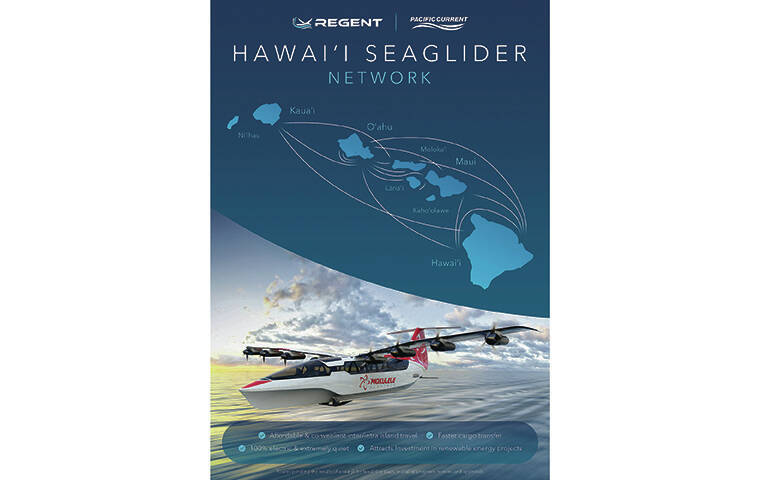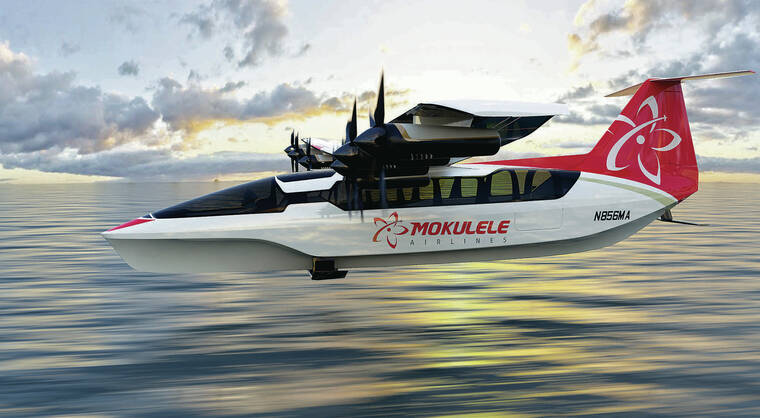All-electric seaglider targeting Hawaii takeoff

COURTESY REGENT

RENDERING COURTESY REGENT
Mokulele Airlines has signed on to be a partner with REGENT and Pacific Current to operate seagliders in Hawaii in 2025.

COURTESY REGENT
“It’s like you are riding a boat without the waves.”
Billy Thalheimer
REGENT co-founder and CEO



REGENT and Pacific Current, a subsidiary of Hawaiian Electric Industries, announced today that they are developing a seaglider transportation network in Hawaii, with Mokulele Airlines earmarked to be their first partner for an anticipated launch in 2025.
The all-electric, no-emission, propeller-driven vehicle would take off from sea, fly just the length of a wing over the surface of the ocean and land at docks without touching land. Flights would undergo three stages, starting with floating, picking up speed on its hydrofoil in the harbors and near coastal areas, then taking flight and going up to 180 mph while flying about 10 to 30 feet above the water’s surface.
A 12-seater Viceroy model could hit the market in 2025, followed by a 100-seater Monarch, which is planned for 2028. The maximum distance is expected to be 180 miles with up to 500 miles from the next generation of batteries.
REGENT co-founder and CEO Billy Thalheimer said during an interview with the Honolulu Star-Advertiser, “It’s like you are riding a boat without the waves.”
Passengers would board the vehicle from docks like they do for ferries, avoiding traditional airports and security lines. The technology and the ability to avoid airports means quicker trips. It creates a pathway to provide intraisland routes like Kaanapali to Kahului on Maui, Kona to Hilo on Hawaii island, or Oahu’s North Shore to Waikiki. Helicopters could be replaced on tourist routes.
Thalheimer said Boston-based REGENT and its partners are working on new vessel certification and rule development. As a U.S. vessel it will need to be compliant with the Jones Act, which requires vessels carrying goods between two U.S. points to be American built, as well as American owned, crewed and flagged.
Don't miss out on what's happening!
Stay in touch with breaking news, as it happens, conveniently in your email inbox. It's FREE!
Domestically it would fall to the U.S. Coast Guard rather than the Federal Aviation Administration to handle oversight for the new technology, which harks back to Hawaiian Airlines’ early days flying Sikorsky seaplanes interisland — except in this case they are all-electric.
Thalheimer said the all- electric seaglider emerged from his partnership with REGENT’s co-founder, Mike Klinker, his best friend since their freshman year at the Massachusetts Institute of Technology. They later worked in electrical and autonomous vehicles, then at Aurora Flight Sciences, which they left in late 2020.
While the seaglider’s wing-and-ground technology has been around since the 1960s, in the past it had issues with harbor maneuverability and wave tolerance. Thalheimer said he and Klinker addressed these challenges with their experience in electric aviation and their knowledge of the burgeoning hydrodynamics technology in the America’s Cup, which used hydrofoils.
“It turns out that by flying on this cushion of air and also by having this ability to sort of pull over on the side of the road and land on the water we can go twice as far as any electric aircraft technology,” Thalheimer said, adding that the company has taken all manner of wind, weather and climate into seaglider’s design and testing.
REGENT and Pacific Current are jointly funding a feasibility study led by SMS Research to determine if the technology is right for Hawaii. Pacific Current President Scott Valentino said study results are expected in the fall or later this year.
Thalheimer said REGENT began a “community listening tour” last summer.
“We’ve been just really impressed to be working in the Hawaii ecosystem to see how quickly these relationships have formed to see how forward leaning the government is and the community is on this new technology,” he said. “We are not skipping any steps here but there is really this excitement and this passion for a project like this.”
Staying in the good graces of the community, planning for inclement weather and rough waters, as well as startup costs will be key to moving ahead, as evidenced by the cautionary tale of the Hawaii Superferry.
Protesters in 2007 blocked the Hawaii Superferry from docking in Kauai. There were complaints about rough rides during the winter waves. The Superferry ran primarily between Honolulu and Maui from 2007 and 2009, when a court ordered it to stop running because it had not done a proper environmental review.
It was a costly gamble. Hawaii spent at least $34 million on equipment for the ferry, which it later sold for just $425,000. The Superferry filed for bankruptcy, leaving hundreds of millions of debt in its wake.
Kuhio Lewis, CEO of the Council for Native Hawaiian Advancement, said in a statement: “We appreciate that REGENT has been engaging community and environmental groups early in the process. Their commitment to building relationships with the community demonstrates that they genuinely care about Hawaii’s people and want to do right for our islands.”
So far no one in Hawaii has experienced the seaglider, though REGENT currently is conducting testing in Florida of a quarter-scale prototype of the Viceroy.
Stan Little, CEO of Mokulele, a Southern Airways Co., said he has ordered $250 million worth of REGENT’s 12-passenger Viceroys with an option to purchase the 100-seater model.
“Originally our plan has been that these are the perfect vehicle for some routes near our headquarters here in South Florida leaving out of Palm Beach and Fort Lauderdale and Miami,” Little said. “We also believe that these are very well designed for our routes in New Eng land Nantucket and the Boston area.
“But we are very open pending these talks that we are having with folks in the state of Hawaii to make Hawaii potentially the inaugural launch. I think that there are few markets that are as well suited for the seaglider. You have an entire state that is almost fully dependent on air travel right now.”
Little said he expects like all new technology that the vessels, which can get passengers closer to their destination than traditional planes, with trips at least 10% to 15% faster, will need consumer buy-in.
“I think that there are still some people that are skeptical of electric automobiles. So yes, there is going to be acceptance curve, which is the reason why we don’t intend to fully switch from aircraft to seagliders,” he said.
Little said that he planned to be in Honolulu this week to talk about Mokulele’s future with government officials and utility leaders. He wants to have discussions about “where Mokulele can effectively deploy the infrastructure. Where do the people of Hawaii want to have these routes located? And, what’s going to be required to have docks and charging infrastructure?”
Startup costs are higher than buying traditional aircraft and bringing them to market, but Little said Mokulele “will save it on the back end.”
Valentino said Pacific Current plans to offer local operators vehicle leasing and financing solutions as well as dock and charging infrastructure as a way of addressing the immense upfront capital costs, which are often a gating factor for wider adoption.
Dock and dedicated charging infrastructure needs are yet to be determined, but Valentino expects that there would be at least one or two on each island, maybe more on Oahu.
“We are really hoping to help the state not only get to 100% RPS (renewable portfolio standards) but also carbon neutral and probably negative by 2045,” Valentino said. “The transportation sector is a major emitter of carbon so it falls squarely within our charter.”
The seaglider would only supply a part of the state’s renewable energy and clean transportation goals. However, Valentino said, “It will be a game changer in terms of offering a clean option to get between the islands that doesn’t exist today.”
If they move forward in Hawaii, all-electric seagliders might become the next disruptor in the interisland aviation market. Competition for Hawaii’s interisland market heated up in 2019 with the entry of Southwest, an industry giant and low-cost carrier.
Hawaiian still dominates the interisland market, although it doesn’t have the monopoly that it had after Island Air ended operations in 2017. Aloha Airlines quit flying the market in 2008, followed by Mesa Airlines, which ended operations of its go! unit in 2014.
It’s unclear how the seaglider might affect interisland service for Southwest, which has an entire fleet comprised of Boeing 737 aircraft, allowing for efficiencies in training, parts and maintenance.
The wild card is Hawaiian Airlines’ announcement this spring that it planned to invest an undisclosed amount in REGENT’s development of the 100-passenger Monarch.
Alanna James, Hawaiian Airlines managing director of sustainability initiatives, said in an email, “Seagliders could be a valuable complement to — but not a replacement for — our existing inter- island operation.
“They have the ability to operate out of different infrastructure and have the potential to serve different geographies within the islands,” she said. “By investing now, we can help inform the design of the vehicle and its supporting infrastructure to better meet our future needs.”
James said Hawaiian Airlines looks forward to working with REGENT, the state and other stakeholders.
“It is important to us to work collectively with stakeholders within our community to ensure that this will be a welcome addition to the transportation system,” she said.
———
The Associated Press contributed to this story.




